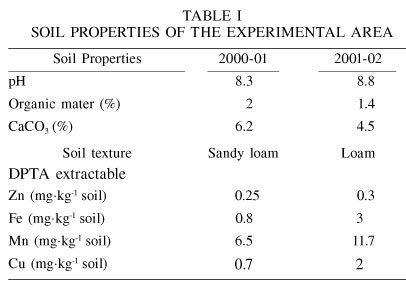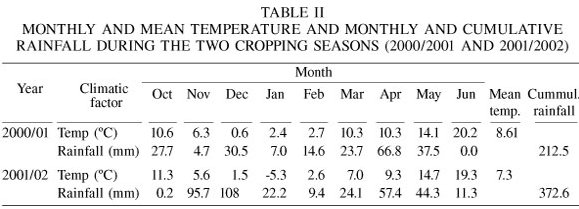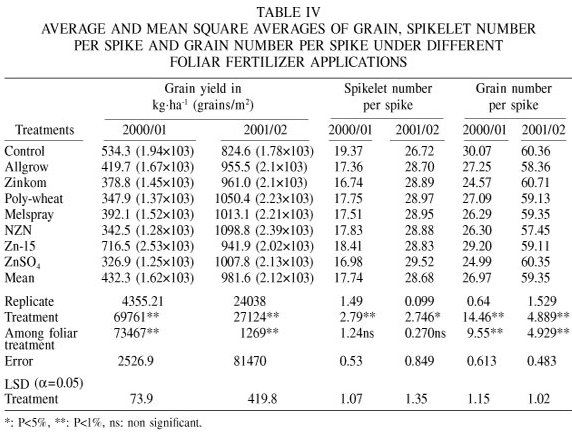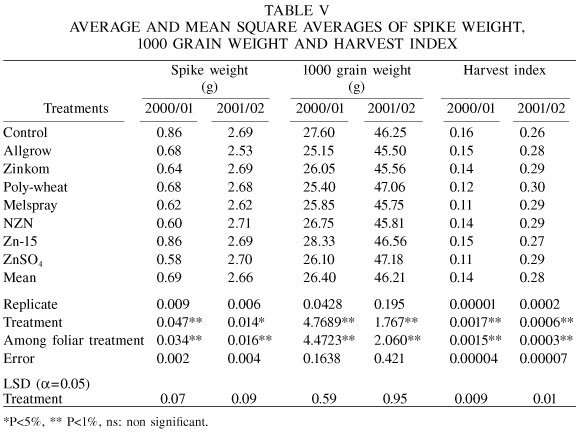Interciencia
versión impresa ISSN 0378-1844
INCI v.32 n.9 Caracas sep. 2007
GRAIN YIELD AND YIELD COMPONENTS OF TRITICALE UPON APPLICATION OF DIFFERENT FOLIAR FERTILIZERS
Engin Kinaci and Nurdilek Gulmezoglu
Engin Kinaci. Ph.D. in Field Crops, Eskisehir Osmangazi University (ESOGU), Turkey. Professor, ESOGU, Turkey.
Nurdilek Gulmezoglu. Ph.D. in Field Crops, ESOGU, Turkey. Professor, ESOGU, Turkey. Address: Department of Field Crops, Faculty of Agriculture, Eskisehir Osmangazi University, 26480 Eskisehir, Turkey. e-mail: dgulmez@ogu.edu.tr
SUMMARY
Field experiments were conducted in the growing seasons of 2000-2001 and 2001-2002 to investigate the effects of various commercial foliar fertilizers containing N, P, K and micro nutrients on yield and yield components of triticale. Yield and yield component values were different among years because of dry season. The results revealed that foliar treatments had significant positive effect on grain yield, spikelet number per spike, number of grain per spike, 1000 grain weight and harvest index in both years. The most effective foliar fertilizer on yield and yield components during drought stress was Zn-15, a chelated (EDTA) form of zinc. Both NZN and ZnSO4 increased grain yield of triticale under no stress conditions.
RENDIMIENTO DE GRANO Y COMPONENTES DEL TRITICAL TRAS LA APLICACIÓN DE DIFERENTES FERTILIZADORES FOLIARES
RESUMEN
En las estaciones de crecimiento de 2000-2001 y 2001-2002 se llevaron a cabo experimentos de campo para investigar los efectos de varios fertilizadores foliares comerciales contentivos de N, P, K y micronutrientes sobre el rendimiento de grano y componentes del tritical. Los valores de rendimientos variaron entre años debido a la estación seca. Los resultados mostraron que los tratamientos foliares tuvieron efectos positivos significativos en ambos años sobre el rendimiento de grano, número de ramillas por rama, número de granos por rama, peso de 1000 granos e índice de cosecha. El fertilizador foliar más efectivo en rendimiento y componentes durante el estrés por sequía fue el Zn-15, una forma quelada (EDTA) del xinc. Tanto NZN como ZnSO4 incrementaron el rendimiento de grano del tritical bajo condiciones sin estrés.
RENDIMENTO DE GRÃOS E COMPONENTES DO TRITICALE APÓS A APLICAÇÃO DE DIFERENTES FERTILIZADORES FOLIARES
RESUMO
Nas estações de crescimento de 2000-2001 e 2000-2002 se realizaram experimentos de campo para investigar os efeitos de vários fertilizadores foliares comerciais contentivos de N, P, K, e de micro nutrientes sobre o rendimento do grão e componentes do triticale. Os valores de rendimentos variaram entre anos devido à estação seca. Os resultados mostraram que os tratamentos foliares tiveram efeitos positivos significativos em ambos os anos sobre o rendimento do grão, número de raminhos por ramo, número de grãos por ramo, peso de 1000 grãos e índice de colheita. O fertilizador foliar mais efetivo em rendimento e componentes durante o estresse por seca foi o Zn-15, uma forma quelada (EDTA) do zinco. Tanto NZN como ZnSO4 incrementaram o rendimento de grão do triticale sob condições sem estresse.
KEYWORDS / Drought / Foliar Fertilizers / Grain Yield / Triticale / Yield Components /
Received: 04/25/2007. Modified: 08/06/2007. Accepted: 08/09/2007.
Introduction
Foliar application of nutrients is highly beneficial, as crop benefits are achieved when the roots are unable to meet the nutrient requirement of the crop at a critical stage (Brar and Brar, 2004). Foliar application of deficient nutrients may be considered as an immediate solution to nutritional problems of plants when the nutrients are not available for root uptake (Randall et al., 1985). The timing of foliar spray, especially during the vegetative growth stages, is critical for the optimum efficiency of the foliar treatment.
Triticale has been produced for many years. Advances in plant breeding have made triticale a viable crop in many parts of the world. Much of the production (FAO, 2004) is as triticale grain, but triticale is also grown as a forage crop and as a dual-purpose crop (both forage and grain). The grain is primarily used for feeding pigs, but it can be and is fed to poultry and ruminant animals, such as cattle and sheep. As forage, the crop can be grazed by cattle and sheep, or harvested for silage or hay. Triticale also produces an abundant amount of straw. Triticale is also more cost-effective than its competitors, as its high lysine content means less protein supplements are required. Australia, the United States, Brazil, Poland and Germany have all adopted triticale for commercial swine rations. Producers have been able to replace other cereals (e.g. wheat, corn, barley and millet) with triticale without losing productivity or product quality (AAFRD, 2005).
Triticale is grown under a wide range of environmental conditions because of its ability to tolerate adverse conditions such as drought, nutrient deficiency, etc. (NRC, 1989). Since triticale is mostly grown in semiarid areas under non-irrigated conditions, nutrients may not be available to its roots when rainfall is low during early spring, a critical time for vegetative growth (Day and Intalap, 1970).
In semiarid regions, such as Central Anatolia, the availability of water has an important effect on crop productivity and is determined by the quantity and distribution of rainfall as well as the capacity of the soil to store water (Gromova and Polacek, 1995; Blum, 1998; Royo and Blanco, 1998; Díaz-Zorita et al., 2001). Foliar application of nutrients to triticale may be advantageous when there is a high risk that the necessary nutrients will be unavailable to plant roots due to adverse soil and climatic conditions (Alaru et al., 2003). Foliar fertilizers are preferable when some micronutrients such as iron and zinc cannot be taken up from soils due to high pH, lime or heavy texture (Randall et al., 1985; Haslett et al., 2001; Erenoglu et al., 2002), a condition often seen in the vast semi arid Central Anatolian region of Turkey, where soils are rich in lime, low in organic matter, and clayey in texture. In addition to this, drought is also often experienced in Central Anatolia (Eyüpoglu et al., 1994; Çakmak et al., 1996; Ekiz et al., 1998; Topal et al., 2003; Gulmezoglu and Kinaci, 2004) and the amount and distribution of precipitation are important factors determining the yields of cereals grown in the region.
Numerous studies have shown the usefulness of spraying micronutrients on grain crops (Brohi et al., 2000; Díaz-Zorita et al., 2001; Kinaci and Kinaci, 2001, 2003; Demirer et al., 2004). However, there are various kinds of foliar fertilizers available on the market with different nutrient contents, which sellers claim to be as effective for yield increase in cereals. Due to the lack of information on the effects of commercial foliar fertilizers on triticale under rainfed conditions, this study has been conducted in order to determine the effects of various commercial foliar fertilizers on grain yield and the yield components of triticale.
Materials and Methods
The experiment was conducted with a winter triticale (cv. Tatlicak 97) during the growing seasons of 2000-2001 and 2001-2002 in Eskisehir, an important cereal growing province of the semi arid Central Anatolian Region of Turkey, located at 39o48N, 30o31E and 789masl.
Soil samples (0-30cm) were collected before planting and dried, passed through a 4mm sieve and analyzed using standard procedures (Black, 1965) for pH, CaCO3, organic matter and texture. Plant available concentrations of Zn, Fe, Mn and Cu in soils were determined according to Lindsay and Norvell (1978) by extraction with DTPA (diethylenetriamine pentaacetic acid) using a soil:solution ratio of 1:2 and shaking time of 2h. The extracted micronutrients were determined by atomic absorption spectrophotometry.
The soil of the experimental site (Table I) was sandy-loam in the first year and loam in the second year. During both years, the soils were low in organic matter, moderate in CaCO3, deficient in Zn (0.2ppm) and possessed no salinity problem.
The average temperature and relative humidity during the two years of the triticale growing period were 8.6 and 61.3%, respectively, in the first year, and 7.3°C and 61.8% in the second year (Table II).
A randomized complete block design with four replications was used for the experiment. Triticale was planted with a 210kg·ha-1 seed rate, and 23.4kg N and 26.5kg P per ha were applied as di-ammonium phosphate (18-46-0) at the time of sowing (Oct 6th in 2000 and Oct 10th in 2001). Each plot (10m2) consisted of six rows, with 17.5cm spacing. Nitrogen topdressing was then applied as 150kg N per ha as ammonium sulphate (21-0-0-24) during the tillering stage in March, and the plants were harvested on July 2nd the first year and on July 17th the second year. The commercial fertilizers Allgrow®, Zinkom®, Poly-wheat®, Melspray®, NZN®, Zn-15®, and ZnSO4, containing one or more of the major nutrients (N, P, K) and micronutrients were used (Table III). The foliar treatments were applied as recommended, at the growth stages as described by Zadoks et al. (1974). Control plots did not receive any foliar application.
The number of grains per spike, spike weight and weight of 1000 grains were determined on 25 randomly selected plants from each plot. The harvest index and grain yield (kg·ha-1 at 11% moisture) were also determined for each plot.
The data for the two years were analyzed for variance using the statistical package, MSTAT-C (MSTAT, 1984). The differences between means were compared by least significant differences. Statistical significance was considered at P<0.05.
Results and Discussion
Cumulative rainfall was 212.5mm in the first year and 372.6mm in the second year at the time of the growing season, which reveals quite contrasting rainfall regimes (Table II). Drought was severe from the period of heading to maturity in the first year, due to the almost total absence of rainfall at that stage. Water deficiency during the period of anthesis is critical to normal cereal production, causing significant yield losses (Aspinall, 1984; Royo and Blanco, 1998; Díaz-Zorita et al., 2001). The period from heading to maturity in the second year was excessively rainy, with 40% of the total precipitation of the growing season (Gulmezoglu and Kinaci, 2004).
Grain yield and the values of yield components were significantly lower in the first year than in the second year (Table IV). Treatment with Zn-15 (716.5kg·ha-1) led to a higher yield (P<0.01) than all of the other foliar fertilizers in the first year, followed by the control (untreated by foliar fertilizers; 534.3kg·ha-1). NZN (1098.8kg·ha-1) produced the highest yield (P<0.01) and grains per unit in second year, followed by Poly-wheat (1050.4kg·ha-1), Melspray, ZnSO4, Zinkom, Allgrow, Zn-15 and, finally, the control (824.6kg·ha-1).
Poly-wheat had the largest spikelet number per spike (28.97), followed by Melsprey (28.95), while the control had the lowest spikelet number per spike (26.7) in the second year (Table IV). In the first year, drought limited the effect of the foliar fertilizers and this effect was found to be statistically significant (P<0.01). The control demonstrated the highest spikelet number per spike (19.37) while the lowest spikelet number per spike (16.74) was obtained with Zinkom.
The grain number per spike was significantly affected by treatments (P<0.01) in both years. It was lower in the first year (Table IV), with a resulting effect on the grain yield. The highest grain number per spike was obtained with Zn-15 application (29.20), and aside from the control, the lowest grain number per spike was obtained with Zinkom (24.57). However, Zinkom led to the highest yield (60.71) in the second year.
The spike weight (Table V) was statistically significant (P<0.01) under the different treatments, the highest being obtained with Zn-15 and the control (0.86g each) in the first year. With the effect of high precipitation in the second year, spike weight was the highest for NZN (2.71g).
The foliar fertilizers affected significantly the 1000 grain weight of triticale (P<0.05). In the first year it was lower than that in the second year (Table V). The highest 1000 grain weight (28.33g) was obtained in the first year with the Zn-15 application, followed by the control (27.6g). ZnSO4 treatment produced the highest 1000 grain weight (47.18g) in the second year and the Allgrow treatment showed the lowest value (45.5g).
The harvest index (Table V) was significantly affected in both years by foliar fertilizer application (P<0.05). The harvest index was higher for the control (0.16) in the first year but, in contrast, the lowest value for the second year (0.26) was obtained for the control. Parallel to grain yield, the harvest index was low in the dry year. The Poly-wheat treatment (0.30) in the second year yielded the highest harvest index.
Higher grain yield and yield component values under drought conditions were obtained from Zn-15 application containing Zn as Zn-EDTA, a chelated form of Zn. In semi-arid regions it is safe to use Zn-15 if drought is present, often in spring, as it is absorbed more easily by leaves than the non-chelated forms (Boawn, 1973; Modaihsh, 1997). Thus, it affected the grain yield and yield components positively. In the unstressed environment, the grain yield at NZN application was the highest. The soil properties of the Central Anatolian Region are expedient for the conversion of ammonium to nitrate, which is much more mobile and can easily be leached by drainage water. Besides nitrogen fertilizers, NZN application may also be advantageous because it supplies plants with Zn, which is deficient in the region (Çakmak et al., 1999; Kinaci and Kinaci, 2001, 2003). It supports the nitrogen given as basal treatment in October, which may have been leached somewhat by rainfall. NZN is an elemental and non-chelated form of zinc. The data for grain yield in unstressed environment indicated that NZN induces a more favorable response than Zn EDTA and the other foliar fertilizers, possibly because the NZN provides zinc to the deficient soil.
The highest mean increase in grain yield and yield components for the two years was under NZN treatment. This may be explained by the high response obtained under the unstressed environment from NZN application. Zn-15 gave the lowest increase and ZnSO4 treatment did not affect the yield and yield components in the drought environment, but it was most efficient under no stress. ZnSO4 may also be considered for supplying zinc via foliar application to triticale, when determined visually under conditions of moderate to severe deficiency.
Results of variance analysis showed that foliar treatments have a significant positive effect on spikelet number per spike, number of grains per spike and harvest index, in both years. Grain yield and 1000 grain weight were affected positively in the first year, when precipitation was high. This means that foliar applications are not advisable in general for triticale in dry years.
While foliar applications affected significantly the grain yield, spikelet number per spike and grain number per spike in both years, significant differences were found among foliar fertilizers in terms of the effect on grain yield and grain number per spike (P<0.01). However, no difference was obtained for spikelet number per spike.
Foliar fertilizer treatments were significantly effective on spike weight, 1000 grain weight and harvest index in both years. There was a significant difference among fertilizers in terms of effect on traits.
Foliar application rates are much lower than those of soil applications, uniform distribution is easily obtained, and response to the applied nutrient is almost immediate, meaning that deficiencies can be corrected during the growing season. Moreover, foliar application can play a significant role in preserving the quality of the environment (Jensen and Spliid, 2003). This study was conducted in a semiarid cultivation area, but it also will be useful for an area under climatic conditions of the Central Andes, where the mean annual precipitation is of 370mm (Bottner et al., 2006).
It is concluded that, in environments such as those investigated in this study, it is possible to supply adequate amounts of nutrients, with special regard to micronutrients, to triticale via foliar sprays, when the nutrient is deficient in the soil. Triticale may be grown in wheat producing areas of Latin America and the Caribbean region, as a dual purpose crop (both forage and grain) for producers of dual purpose (milk and beef) cattle.
AcknowledgementS
This research was funded by the Research Fund of the Eskisehir Osmangazi University, Turkey.
References
1. AAFRD (2005) Triticale Production and Utilization Manual 2005. Chapman B, Salmon D, Dyson C, Blackley K (Eds.). Alberta Agriculture, Food & Rural Development. Canada.. 78 pp. [ Links ]
2. Alaru M, Laur Ü, Jaama E (2003) Influence of nitrogen and weather conditions on the grain quality of winter triticale. Agron. Res. 1: 3-10. [ Links ]
3. Aspinall D (1984) Water deficit and wheat. In Pearson CJ (Ed.) Control of Crop Productivity. Academic Press. Sidney, Australia. pp. 91-110. [ Links ]
4. Black CA (1965) Methods of Soil Analysis. Agronomy 9, Part 2. American Society of Agronomy. Madison, WI, USA. XXX pp. [ Links ]
5. Blum A (1998) Improving wheat grain filling under stress by stem reserve mobilization. In Braun HJ, Altay F, Kronstad WE, Beniwal SPS (Eds.) Wheat: Prospects for Global Improvement. Kluwer. Dordrecht, The Netherlands. pp. 135-141. [ Links ]
6. Boawn L (1973) Comparison of zinc sulfate and zinc EDTA as zinc fertilizer sources. Proc. Soil Sci. Soc. Am. 37: 111-116. [ Links ]
7. Bottner P, Pansu M, Sariento L, Hervé D, Callisaya-Bautista R, Metselaar K (2006) Factors controlling decomposition of soil organic matter in fallow systems of the high tropical Ande: A field simulation approach using 14C- and 15N-labelled plant material. Soil Biol. Biochem. 38: 2162-2177. [ Links ]
8. Brar MS, Brar AS (2004) Foliar nutrition as a supplement to soil fertilizer application to increase yield of upland cotton (Gossypium hirsutum). Indian J. Agric. Sci. 74: 472-475. [ Links ]
9. Brohi AR, Karata H, Ozcan S, Demir M (2000) Effect of soil and foliage zinc sulphate application on yield and on some plant nutrient uptake of bread wheat crop grown on zinc deficient soils. G.O.Ü. J. Agric. Faculty. 17: 123-128 (in Turkish). [ Links ]
10. Çakmak I, Yilmaz A, Kalayci M, Ekiz H, Torun B, Braun HJ (1996) Zinc deficiency as a critical problem in wheat production in Central Anatolia. Plant Soil. 180: 165-172. [ Links ]
11. Çakmak I, Kalayci M, Ekiz H, Braun HJ, Kilinc Y, Yilmaz A (1999) Zinc deficiency as a practical problem in plant and human nutrition in Turkey: A NATO-science for stability project. Field Crop. Res. 60: 175-188. [ Links ]
12. Day AD, Intalap S (1970) Some effects of soil moisture stress on the growth of wheat (Triticum aestivum L. Em Tell.). Agron. J. 62: 27-29. [ Links ]
13. Demirer T, Ozer I, Kocturk OM, Er AY (2004) Effects of different leaf fertilizers on yield and quality in sunflower (Helianthus annuus L.). Pakistan J. Biol. Sci. 7: 384-388. [ Links ]
14. Díaz-Zorita M, Fernández-Canigia MV, Grosso GA (2001) Applications of foliar fertilizers containing glicinebetaine improve wheat yields. J. Agron. Crop Sci. 186: 209-215. [ Links ]
15. Ekiz H, Öztürk L, Baci SA, Gültekin I, Yilmaz A, Çakmak I (1998) Effect of zinc deficiency on drought susceptibility of wheat. I. Ulusal Çinko Kongesi, Kemal Matbaasi, pp. 511-517 (in Turkish). [ Links ] 16. Erenoglu B, Nikolic M, Römheld V, Çakmak I (2002) Uptake and transport of foliar applied zinc (65Zn) in bread and durum wheat cultivars differing in zinc efficiency. Plant Soil. 241: 251-257. [ Links ] 17. Eyüpoglu F, Kurucu N, Sanise U (1994) Status of plant available micronutrients in Turkish soils. In Annual Report Nº R-118. Soil and Fertilizer Research Institute, Ankara, Turkey. pp. 25-32 (in Turkish). [ Links ] 18. FAO (2004) Triticale improvement and production. Mergoum M, Gómez-Macpherson H (Eds.). Plant Production and Protection Paper Nº 179. FAO. Rome, Italy. 172 pp. [ Links ] 19. Gromova Z, Polacek M (1995) Uptake of nutrients in triticale. Rostlinna Vyroba. 41: 71-75. [ Links ] 20. Gulmezoglu N, Kinaci E (2004) Efficiency of Different Topdressed Nitrogen on Triticale (X Triticosecale Wittmack) under Contrasting Precipitation Conditions in Semiarid Region. Pakistan J. Biol. Sci. 7: 353-358. [ Links ] 21. Haslett BS, Reid RJ, Rengel Z (2001) Zinc mobility in wheat: Uptake and distribution of zinc applied to leaves or roots. Ann. Bot. 87: 379-386. [ Links ] 22. Jensen PK, Spliid NH (2003) Deposition of spray liquid on soil below cereal crops after applications during the growing season. Weed Res. 43: 362-370. [ Links ] 23. Kinaci G, Kinaci E (2001) Effects of various foliar fertilizers on yield and quality characteristics of wheat. S.Ü. J. Agric. Fac. 15: 115-123 (in Turkish). [ Links ] 24. Kinaci G, Kinaci E (2003) Effects of various foliar fertilizers on yield and some agronomic characteristics of maize. Ç.Ü. J. Agric. Fac. 18: 7-14 (in Turkish). [ Links ] 25. Lindsay WL, Norvell WA (1978) Development of a DTPA soil test for zinc, iron, manganese and copper. Soil Sci. Soc. Am. J. 42: 421-428. [ Links ] 26. Modaihsh AS (1997) application of chelated and non-chelated metals for supplying micronutrients to wheat grown on calcareous soil. Exp. Agric. 33: 37-245. [ Links ] 27. MSTAT (1984) MSTAT-C Microcomputer Statistical Program. Michigan State University. East Lansing, MI, USA. [ Links ] 28. NRC (1989) Triticale: A Promising Addition to the Worlds Cereal Grains. National Academy Press. Washington, DC, USA. 103 pp. [ Links ] 29. Randall GW, Wells KL, Hanway JJ (1985) In Engelstad OP (Ed.) Fertilizer Technology and Use. Soil Science Society of America. Madison, WI, USA. pp. 552-556. [ Links ] 30. Royo C, Blanco R (1998) Use of iodide to mimic drought stress in triticale. Field Crop Res. 59: 201-212. [ Links ] 31. Topal A, Yalvaç K, Akgün N (2003) Efficiency of topdressed nitrogen sources and application times in fallow-wheat cropping system. Com. Soil Sci. Plant Anal. 34: 1211-1224. [ Links ] 32. Zadoks JC, Chang TT, Konzak CF (1974) A decimal code for the growth stages of cereals. Weed Res. 14: 415-421. [ Links ]












 uBio
uBio 





